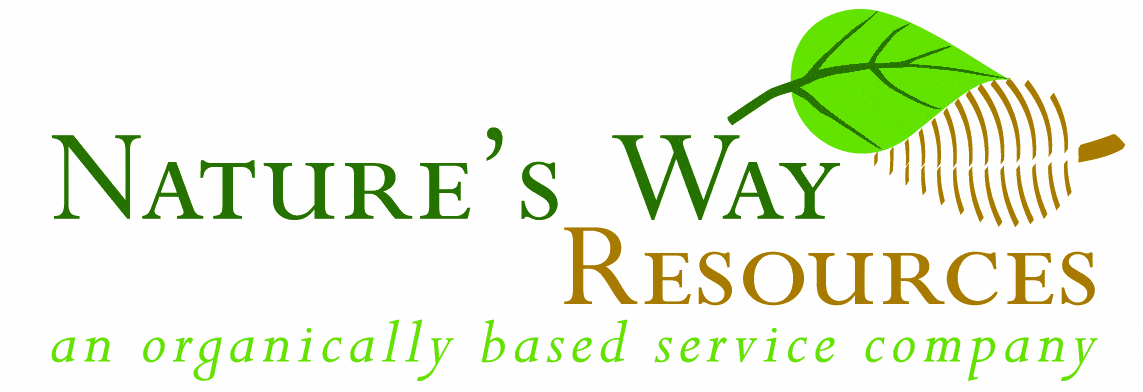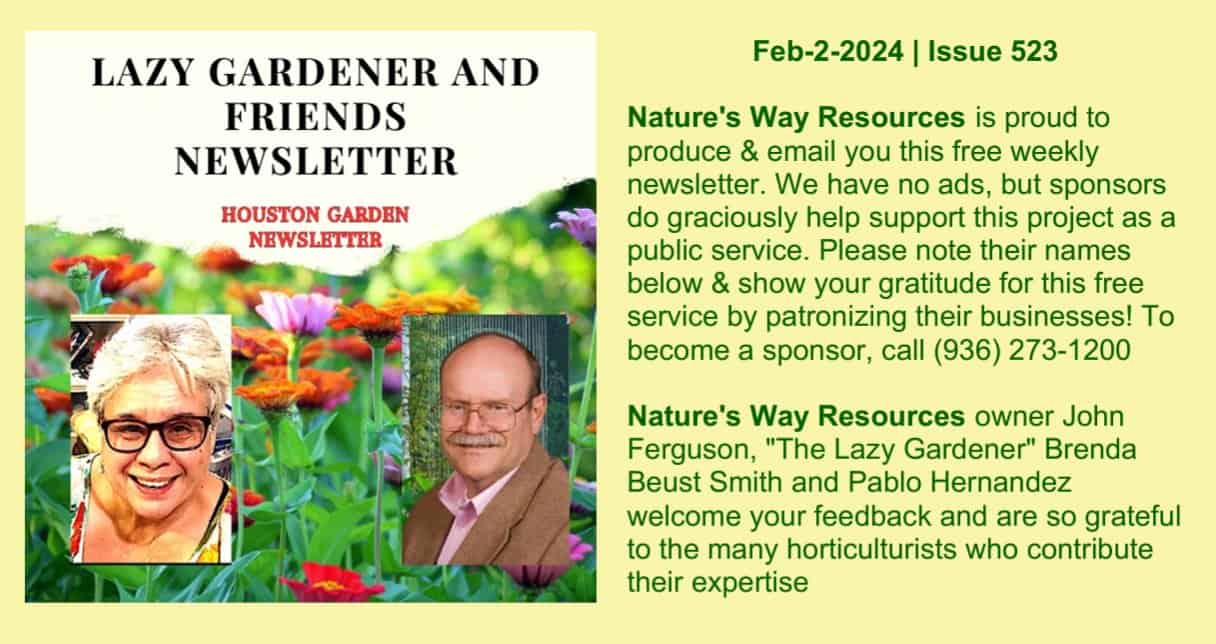
Brenda will be back soon…
IN OUR SPOTLIGHT ARTICLE BELOW, Ceil Dow, Ginger Grower for Friends of Mercer Botanic Gardens, gives a glimpse into fabulous gingers that will be available at the 2024 March Mart, Fri.,-Sat., Mar 22 & 23.
* * *
Brenda Beust Smith’s column is based on her 40+ years as
Houston Chronicle’s Lazy Gardener — Email: lazygardenerbrenda@gmail.com Note: This column focuses ONLY on the Greater Houston area.
* * *
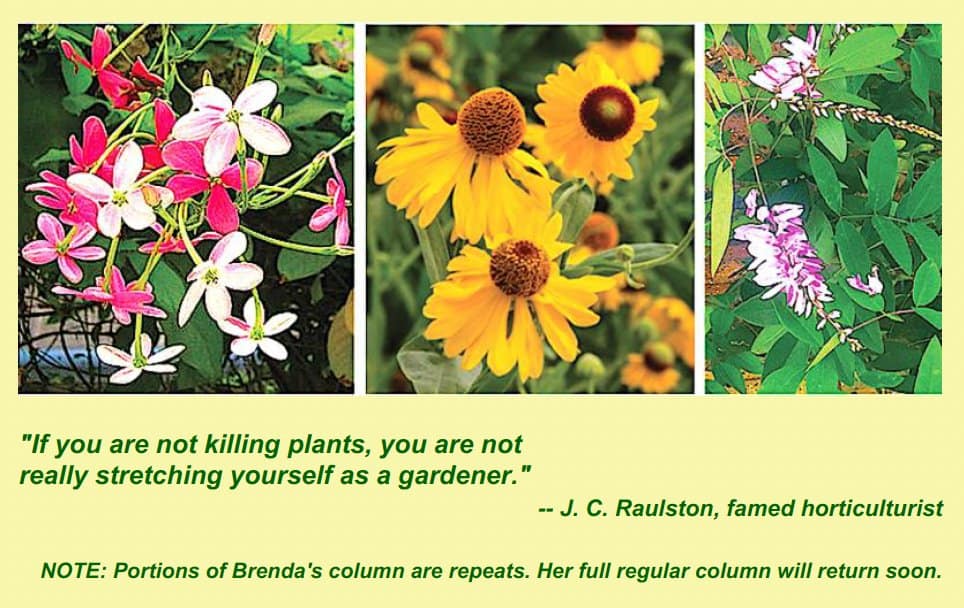
BIG AL’S FUTURE WINTER FORECAST, SHADE PLANTS AND WILD NEIGHBORS!
By BRENDA BEUST SMITH
GROUNDHOG ALERT! Today, Groundhog Day, will determine if 91-year-old Big Al continues his 100% accurate predictions. (The ‘Hog’s accuracy rate is only 39% accuracy)! Beaumont’s Gator
Country live noon Facebook airing of Big Al’s feeding will hopefully signal no more hard winter weather. If he doesn’t eat, winter continues. Big Al, at 13-foot, once ranked as the nation’s largest alligator in captivity. (Note: alligator’s digestive systems slow way down until winter is over.)
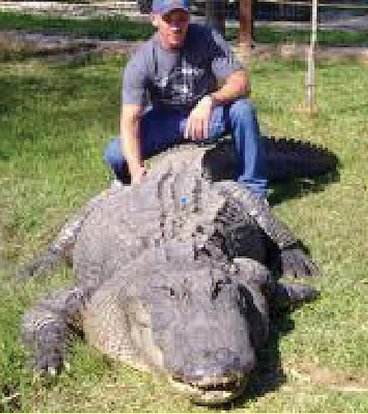
* * *
NEED SHADE-LOVING PLANT? We are so blessed in this area with an abundance of gorgeous trees. But they, in turn, do cast a lot of shade.When asked for suggestions of vines that bloom in shade, I have to be honest. In deep shade, not many. In fact, I couldn’t think of any.
But most shade is not “deep.” Most is filtered as sun rays penetrate through the leaf canopy at different times of day. Usually at least an hour or more of direct sun hits the spot at different times of the year.
The good news is, with our extremely intense sun with its reflected heat and rays, these few, even temporary, penetrations might be all a vine needs to at least deserves a chance.
I’d love it if you readers could add any of your success stories with vines not mentioned below. But first, couple of thoughts:
Don’t overlook the potential for blooming vines to be great groundcovers. Or to add color to nonblooming groundcovers used under trees, etc., where St. Augustine refuses to grow. Consider planting these in containers set into the groundcover.
Groundcovers spread by producing spreading foliage that roots into the ground. Vines spread from a single base by producing tendrils that will also root if in contact with soil but which don’t need to.
Researching shade blooming vines online can be frustratingly confusing for us. Sweet autumn clematis, honeysuckle, wisteria and trumpet creeper are frequently recommend as shade vines. But all four are now very invasive in our subtropical area. You’ve been forewarned!
Expect vines to grow longer tendrils here than listed in descriptions if your sources is not based in the Greater Houston area.
Many vines listed as annuals in nationwide lists will be perennial here if well mulched. Give them a chance to return in spring.
Get to know your yard. The sun moves around the sky. Shade spots now might be sunnier in July.
All these below attract butterflies, hummingbirds or both as well as other
pollinators and thrive in a wide variety of soils. All benefit from a good organic mulch and (unless labeled evergreen) are all root-hardy which means will die back in cold and return in spring.
Best bet: always first consult your local neighborhood nurseryman. He/she shares your growing environment, your challenges and has on hand good-for-you, often brand new, recommendations ready to try.
Starting with him/her may make your search much easier than traipsing around town trying to find specific plants.
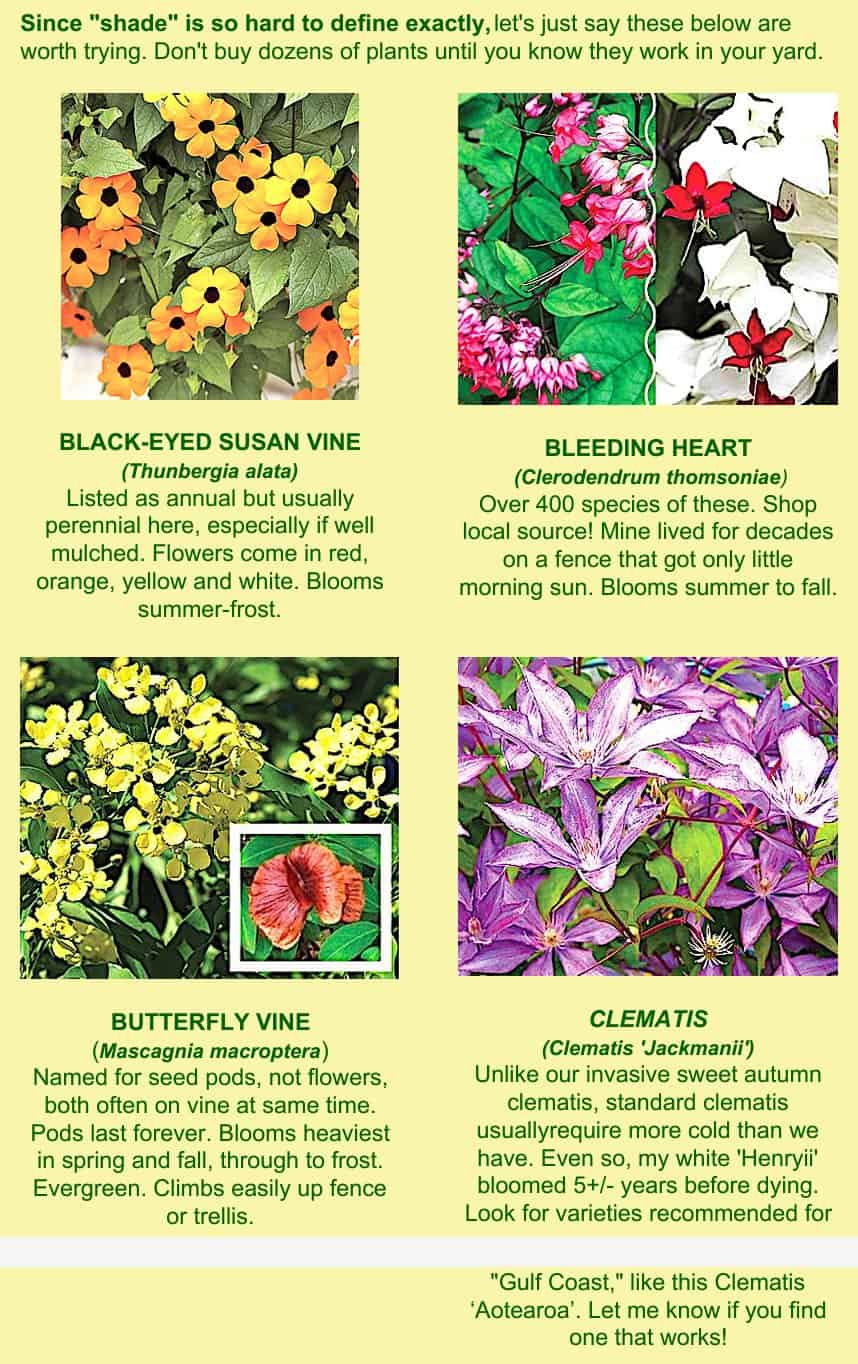
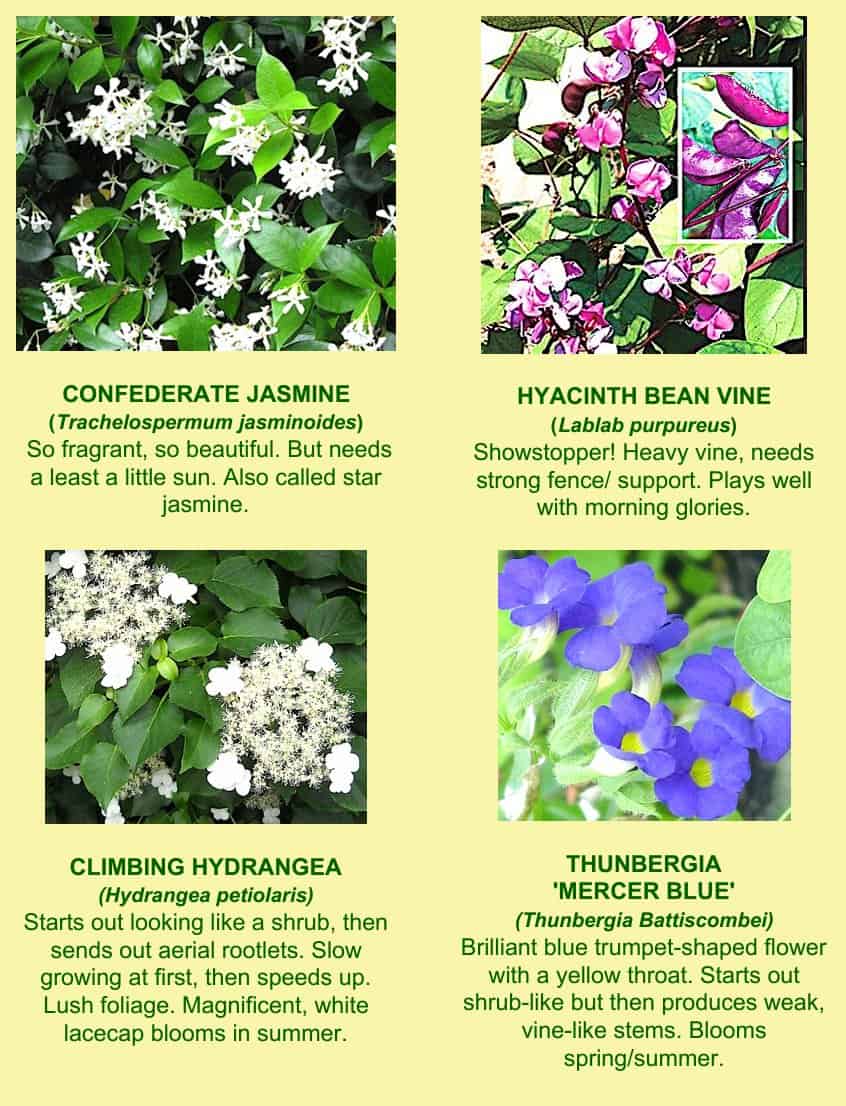
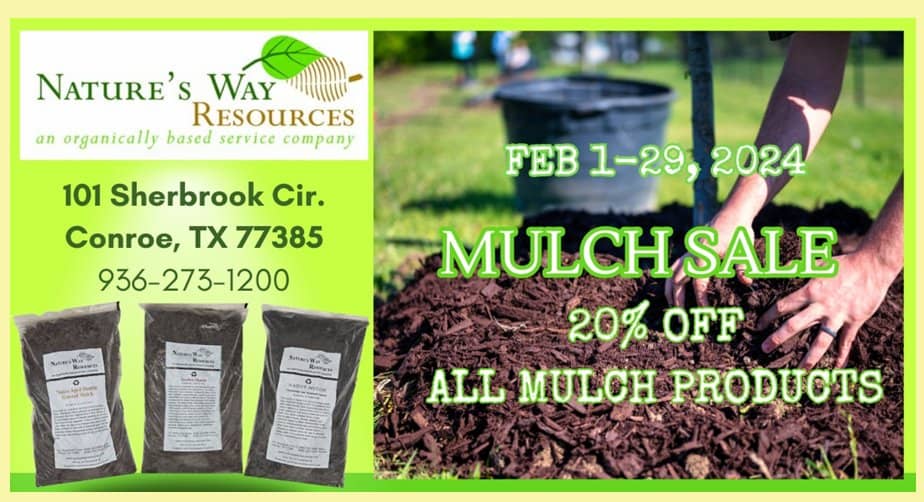

NEWS FROM THE WONDERFUL WORLD OF SOIL AND PLANTS # 271
Subject: Spring Chores, Mulch And Turning Clay Into Soil
I was at my farm a few days ago and I noticed the buds on my Buckeyes were swollen, a sure sign that spring is right around the corner. This made me think of the spring gardening chores I needed to get done.
After the freeze a few weeks ago, there is a lot of dead foliage that needs to be trimmed back. Last year I purchased a DeWalt battery powered hedge trimmer and it has become one of my favorite garden tools. It has a lot of power and will easily cut branches over ¼ inch thick. No more dragging a long extension cord all over the yard.
In my yard in Houston, I have several species of Salvia’s that cover a large portion of my yard that are now dead sticks. In years past I would have to use my hands or hand pruners to cut them a tedious time-consuming task.
I now use the hedge trimmer to cut them into 3-4-inch-long pieces that just fall to the ground adding to the mulch layer. After a few passes, they are cleared to the ground and ready for spring growth. What used to take hours now takes only a few minutes.
Now that the dead material has been removed it is time to make sure all my beds are mulched. Mulching is one of the most important gardening practices one can do and is also the one most often neglected or done incorrectly.
I live in southwest Houston with the black clay (Beaumont-Lake Charles clay). It is fertile but difficult to work in, hard as a rock in summer and slippery and sticky when wet, swells and shrinks tearing up roots.
Canada’s department of forestry has funded research on every continent studying how to improve clay soils for decades. They found that a native mulch (properly made) improves clay soils better, faster, and cheaper than any other
technology.
I have been using aged Native Mulch from Nature’s Way Resources for many years. Over time the clay has broken down into a rich beautiful fertile loam that can grow anything. My yard was featured in Better Homes and Garden’s back in the Spring 2000 issue. The soil was so rich that I was able to go over 14 years without needing to water my lawn or garden. I will miss this soil when I move to my retirement home in a few weeks where I will have to start over.
On my website there are numerous articles on mulches that can be found at https://www.natureswayresources.com/mulchcorner.html
One can also search the Newsletter archive for additional articles on Native Mulch.

SPONSORSHIP
If you are interested in becoming a sponsor, please contact us at 936-273-1200 or send an e-mail to: lazygardenerandfriends@gmail.com

ABOUT US
BRENDA BEUST SMITH WE KNOW HER BEST AS THE LAZY GARDENER . . . but Brenda Beust Smith is also:
- a national award-winning writer & editor
- a nationally-published writer & photographer
- a national horticultural speaker
- a former Houston Chronicle reporter
When the Chronicle discontinued Brenda’s 45-year-old Lazy Gardener” print column — started in the early ’70s as a fun side-project to reporting, it then ranked as the longestrunning, continuously-published local newspaper column in the Greater Houston area. The name, she says, is not just fun, it’s true. Brenda’s gradual sideways step from reporter into gardening writing led first to an 18-year series of when-to-do-what Lazy Gardener Calendars, then to her Lazy Gardener’s Guide book which morphed into her Lazy Gardener’s Guide on CD, which she now emails free upon request. Brenda became a Harris County Master Gardener and, over the years, served on theboards of many Greater Houston area horticulture organizations. She hosted local radio and TV shows, most notably a 10+-year Lazy Gardener specialty shows on HoustonPBS (Ch. 8) and her call-in “EcoGardening” show on KPFT-FM. For over three decades, Brenda served as Assistant Production Manager of the GARDEN CLUB OF AMERICA’S “BULLETIN” magazine. Although still an active broad-based freelance writer, Brenda’s main focus now is THE LAZY GARDENER & FRIENDS HOUSTON GARDEN NEWSLETTER with John Ferguson and Pablo Hernandez of Nature’s Way Resources. A native of New Orleans and graduate of St. Agnes Academy and the University of Houston, Brenda lives in Humble, TX, and is married to the retired Aldine High School Coach Bill Smith. They have one son, Blake. Regarding this newsletter, Brenda is the lead writer, originator of it and the daily inspiration for it. We so appreciate the way she has made gardening such a fun way to celebrate life together for such a long time.
JOHN FERGUSON John is a native Houstonian and has over 27 years of business experience. He owns Nature’s Way Resources, a composting company that specializes in high quality compost, mulch, and soil mixes. He holds a MS degree in Physics and Geology and is a licensed Soil Scientist in Texas. John has won many awards in horticulture and environmental issues. He represents the composting industry on the Houston-Galveston Area Council for solid waste. His personal garden has been featured in several horticultural books and “Better Homes and Gardens” magazine. His business has been recognized in the Wall Street Journal for the quality and value of their products. He is a member of the Physics Honor Society and many other professional societies. John is is the co-author of the book Organic Management for the Professional. For this newsletter, John contributes articles regularly and is responsible for publishing it.
PABLO HERNANDEZ Pablo Hernandez is the special projects coordinator for Nature’s Way Resources. His realm of responsibilities include: serving as a webmaster, IT support, technical problem solving/troubleshooting, metrics management and quality control. Pablo helps this newsletter happen from a technical support standpoint.
Download the Newsletter with Our Events Calendar Below!
